All 6 entries tagged Postgraduate Research
No other Warwick Blogs use the tag Postgraduate Research on entries | View entries tagged Postgraduate Research at Technorati | There are no images tagged Postgraduate Research on this blog
May 01, 2020
Cult Development in Provincial Syria
|
|
Introduction
I will use the above coinage to briefly explore the developments of a Syrian cult and thus the relationship between local cults and Roman (military) presence in the eastern provinces.
Pictured in fig.1 is a rare tetradrachm minted in the 3rd century AD under Caracalla. The tetradrachm may have been the principal unit of silver coinage used in Syria during this period, but the iconography on the reverse makes this coin intriguing. It is thought to depict cult statues belonging to the Temple of Ataragtis and Hadad (Syrian gods) at Hierapolis (Syria).
Cultic and Civic Context
The cult of Atargatis and Hadad was Syrian in origin and the sanctuary pre-dated Greek/Macedonian conquest. From Seleucid rule to the late third century AD Hierapolis was a provincial religious hub and mustering point for the Roman military. The Greek legend on a similar bronze coin under Severus Alexander (fig.2): ΘΕΟΙ CYRIAC IEPOΠΟΛΙΤΩΝ ‘the gods of Syria, (coin) of the Hieropolitans’ helps identify the figures represented on the Caracalla coin. Near-contemporary written accounts and artwork from Syria corroborate this.
 |
|
Fig.2 Bronze coin of Hierapolis, minted under Severus Alexander (222-235 AD).
Obverse: Radiate bust of Severus Alexander right, AYT KAI MAP AYΡ CE - ΑΛΕΞΑΝΔΡΟC [CEB].
Reverse: Image of the Syrian gods of the Hierapolitans: Hadad left, seated on throne; Atargatis right, seated on throne; ensign between them. Below lion walking right; ΘΕΟΙ CYRIAC IEPOΠΟΛΙΤΩΝ.
Photo credit: Staatliche Museen zu Berlin, Münzkabinett.
|
It seems that a variety of peoples worshipped at this sanctuary, and thus the deities were attributed a variety of names and associated myths. The Greeks called Atargatis ‘Hera’ (and Aphrodite) and Hadad ‘Zeus’. Lucian, writing in the second century AD, describes the ionic temple with its cult statues of Atargatis and Hadad sitting on their thrones borne by lions and bulls respectively, as Caracalla’s coin depicts. These specific deities are further identified by their tall headdresses and attributed objects. Both deities hold sceptres in their left hands and Atargatis holds a spindle in her right hand, as Lucian describes. It is thought that Hadad may be holding either a thunderbolt or ear of corn in his right hand.
Between the cult statues themselves was an ensign, called a ‘semeion’. Its exact nature has been disputed. Lucian writes: ‘between both of these [statues] stands another golden statue. It does not have its own shape but bears the images of the other gods’. I agree with Darcus that here Lucian is likely referring to the images of Atargatis and Hadad (or some other ‘indigenous’ gods).
Roman Military Symbols and Indigenous Gods
The near identical ensigns on the coins comprise of hollow rings on staffs. Gabled pediments top them with doves at the summits. They bear a clear resemblance to Roman military standards. Another similar standard in the same iconographical context can be seen in a relief from fellow Syrian city, Dura-Europos (fig.3). The relief depicts a specific type of military standard with cloth banners called a ‘vexillum’. Based on other archaeological evidence Dura has yielded, this vexillum type seems to have been the most common there. The same vexillum has been identified by some scholars on the coins of Caracalla and Severus.
 |
|
Fig.3 Relief from Dura-Europos,
second or third century AD.
On the left Hadad; the right Atargatis;
between them the ‘semeion’.
Photo credit: Yale University Art Gallery.
|
There is evidence that Roman military standards were housed in shrines in provincial Syria. It seems that in the imperial period these standards possessed their own spirit/sacred powers, offering protection and symbolising the strength of the Roman Empire. Ergo, they were an expression of military ideology and collective identity. The ethnic composition of the army in Syria would have been diverse, with local recruitment having been initiated the previous century. Although the extent to which the Roman military interacted with civilians in provincial Syria is uncertain, it is well known that the Roman military acted as a primary vehicle in the process of cult mobility in imperial times. Thus the cult of Atargatis itself disseminated across the empire: throughout Syria, northern Mesopotamia, the Mediterranean and even made it to Britain.
Fergus Millar noted that the absence of the ensign on earlier coins under Trajan supports the suggestion that the ensign was a later addition to the temple. If there had been a permanent Roman military standard in the temple, it was likely not the ensign Lucian saw. Instead Lucian describes a more indigenous religious ensign, very similar to motifs seen on Syrian cylinder seals dating back to the second millennia BC: staffs bearing the heads of deities with birds on top.
At the bottom of the reverse, an eagle with a lion walking below it can be seen. The exact meanings of these symbols in this context are uncertain. It is possible that this is a visual hierarchy reinforcing imperial positions, a common practice in the provinces: Rome on top, symbolised by Jupiter’s eagle and Hierapolis/Syria below, by a lion of Atargatis. However, the presence of the eagle on Syrian coinage has been traced back to before Roman conquest and on other Syrian coinage the eagle is thought to allude to local myth and history.
Commissioner and Audience?
Knowing the commissioner and audience of a coin helps greatly in attempting to identify the potential meanings of such symbols. Based on the metallurgical composition and style of the Caracalla coin, it has been suggested that it was minted in Rome but it could also have been minted in Syria. Regardless, the coinage almost certainly represents deliberate choices made by the elite, meaning that the imagery could reflect social attitudes of the inhabitants of Hierapolis, attempt to modify them, or even ignore them (although the latter is unlikely).
Additionally, without knowing the circulation of this coinage, it is difficult to say the extent to which the messages were intended for the local community and ‘outsiders’, although in most cases it was predominantly for the former. The Caracalla coin likely only circulated locally, but like many Syrian cities, the inhabitants of Hierapolis would have been culturally diverse. Furthermore, people throughout Syria and other provinces visited and sponsored the cult, so if they had seen this coinage it likely would have resonated with them too, evoking a sense of collective Syrian identity. This may have also been the case for people who were familiar with a similar image, for example the Dura relief.
As for the Roman military present in this area, would they have seen this coinage? Such locally issued silver coinage was used for army pay. Would the juxtaposing of a military standard with the Syrian gods have created a sense of collective identity and unity for soldiers and civilians? Or in this context had the traditionally Roman symbol been transformed into a distinctly local one?
Conclusion
The analysis of this coinage has shown the development of the cultic identity of Hierapolis (Syria). When a Roman military symbol was placed in the local temple context, ‘Romanness’ would have become a part, not just of the religion, but also the local myth and history surrounding the cult. Even if a Roman military standard were not housed in the temple, the desire to express it as such existed and was on public display through this coinage. Thus, Hierapolis reconciled their civic identity with the Roman presence in their society, exhibiting their place in the empire.
This month’s coin of the month was written by Nicholas Aherne. Nicholas studied Classical Civilisation at Warwick and graduated in 2019. He is planning to undertake a Masters in 2020. His current research concerns the interactions between Greco-Roman culture and indigenous cultures in the Hellenistic and Imperial Periods, with particular focus on religion.
Bibliography
Lucian, De Dea Syria, (Perseus)
Darcus, R. (1967) A new translation of Lucian’s De Dea Syria with a discussion of the cult at Hierapolis, MA thesis (Vancouver: University of British Columbia)
Strong, H.A. (1913) The Syrian Goddess: Being a translation of Lucian’s ‘De Dea Syria’ with a life of Lucian, ed. with notes and introduction by Garstang, J. (London: Constable and Company)
Pliny the Elder, Natural History, trans. John Bostock (London: Taylor and Francis : 1855) (Perseus)
Strabo, Geography, trans. H.C. Hamilton (London: George Bell & Sons: 1903) (Perseus)
Andrade, N.J. (2013) Syrian Identity in the Greco-Roman World (Cambridge: Cambridge University Press)
Billing, J. The Military Standards of the Roman Legions: Symbolic objects of ideology, veneration and belief https://www.academia.edu/8640103/The_Military_Standards_of_the_Roman_Legions_Symbolic_objects_of_ideology_veneration_and_belief
Butcher, K. (2005) ‘Information, legitimation, or self-legitimation? Popular and elite designs on the coin types of Syria’ in Coinage and Identity in the Roman Provinces eds. C. Howgego, V. Heuchert, and A. Burnett (Oxford: Oxford University Press) 143-162
Butcher, K. (2004) Coinage in Roman Syria: Northern Syria, 64 BC-AD 253 (London: Royal Numismatic Society)
Butcher, K. (2007) ‘Two Syrian Deities’, Syria 84: 277-285
Butcher, K. and Ponting, M. (1995) ‘Rome and the East: Production of Roman Provincial Silver Coinage for Caesarea in Cappadocia under Vespasian’, Oxford Journal of Archaeology 14: 63-78
Erdkamp, P. (2007) A Companion to the Roman Army (Oxford: Blackwell Publishing)
Howgego, C. (2005) ‘Coinage and Identity in the Roman Provinces’ in Coinage and Identity in the Roman Provinces eds. C. Howgego, V. Heuchert, and A. Burnett (Oxford: Oxford University Press) 1-18
James, S. (2019) The Roman military base at Dura-Europos, Syria: an archaeological visualization (Oxford: Oxford University Press)
Kaizer, T. (2013) 'Identifying the divine in the Roman Near East' in Panthée: religious transformations in the Graeco-Roman Empire eds. L. Bricualt and C. Bonnet, in Religions in the Graeco-Roman world V. 177 (Boston: Brill) 113-130
Meadows, A.R. (1998) ‘The Mars/eagle and thunderbolt gold and Ptolemaic involvement in the Second Punic War’ in Coins of Macedonia and Rome: Essays in Honour of Charles Hersh eds. A. Burnett and U. Wartenberg (London: Spink)
Price, S. (2012) ‘Religious Mobility in the Roman Empire’, The Journal of Roman Studies 102: 1-19
Weiss, P. (2005) ‘The Cities and their Money’ in Coinage and Identity in the Roman Provinces eds. C. Howgego, V. Heuchert, and A. Burnett (Oxford: Oxford University Press) 57-71
Williamson, G. (2005) ‘Aspects of Identity’ in Coinage and Identity in the Roman Provinces eds. C. Howgego, V. Heuchert, and A. Burnett (Oxford: Oxford University Press) 19-28
Wimber, K. Michelle (2007) Four Greco-Roman Era Temples of Near Eastern Fertility Goddesses: An Analysis of Architectural Tradition, MA Thesis (Provo: Brigham Young University)
April 01, 2019
The snake–god and the satirist
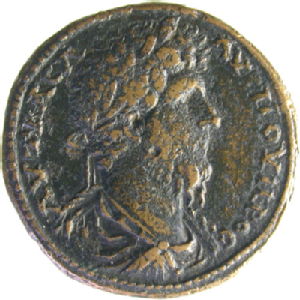 |
 |
This bronze coin from Abonuteichos, on the southern coast of the Black Sea, depicts the snake-god Glycon on the reverse. The serpent is depicted curled up, but with its head raised, and with long hair. It is labelled as ‘ΓΛΥΚΩΝ ΙΩΝΟΠΟΛΕΙΤΩΝ’ (Glycon of the Ionopolitans).
It was minted during the dual reign of Marcus Aurelius and Lucius Verus (AD 161-69). The latter is depicted on the obverse wearing a laurel, along with the legend ‘AVT KAC (sic) Λ ΑΥΡΗ οΥΗΡοC’ (Imperator Caesar L. Aurelius Verus).
This coin is especially interesting as a result of a treatise penned by the second century AD satirist Lucian. Alexander the False Prophet details how the titular Alexander (born c. AD 105-115) managed to con locals and outsiders alike into handing over their money in return for prophecies from Glycon, whose cult he founded. The survival of Lucian’s treatise gives us a fantastic opportunity to tie together material and literary evidence on the cult.
The first thing to notice on this coin is the long, thick hair of the snake, which is somewhat anthropomorphic. Lucian explains that even though the snake was living, a new head was crafted out of linen by Alexander and a colleague before the cult began:
they had long ago prepared and fitted up a serpent’s head of linen, which had something of a human look, was all painted up, and appeared very lifelike. It would open and close its mouth by means of horsehairs, and a forked black tongue like a snake’s, also controlled by horsehairs, would dart out.
Lucian, Alexander 12
Lucian explains how once this stage was complete, Alexander buried tablets prophesying that Asclepius would take up residence in Abonuteichos, which provoked people to build a temple (Lucian, Alexander 10). He then ran around in a frenzy, before ‘discovering’ a goose-egg, from which a baby snake emerged (Lucian, Alexander 13-14).
When the cult opened soon after, people apparently assumed that Glycon, the full-size snake-god shown on this coin, had grown out of this tiny snake within a few days (Lucian, Alexander 16). Lucian claims that when Glycon was being displayed at this grand opening, Alexander concealed its real head under his arm, showing only the linen head to the people (Lucian, Alexander 15). This is in contrast to the depiction on the coin, in which the anthropomorphic head is shown as a part of the snake’s body.
The cult then began offering predictions and oracles for anyone able to pay, and there were plenty of visitors, whom Lucian characterises as ‘thick-witted’ (Lucian, Alexander 17). Alexander would ask them to hand in their requests on scrolls, which he would unroll and secretly reseal, and pretend that the answer he gave them came from Glycon (Lucian, Alexander 19-20). He even purported to make Glycon’s (linen) head speak, thanks to an attendant using a horsehair mechanism and a tube (Lucian, Alexander 26).
Lucian’s account also broadly ties up with other evidence suggested by this coin. For example, the satirist writes that once Alexander gained fame, even in Rome, due to the rapid spread of the cult, he requested that a coin be produced with an image of himself on one side, and Glycon on the other (Lucian, Alexander 58). While we have never found any coins which depict Alexander himself (Jones (1986) 146), this coin shows that half of his desire was granted, at any rate.
According to Lucian, Alexander also requested that the Emperor change the name of his city from Abonuteichos to Ionopolis (Lucian, Alexander 58). Petsalis-Diomidis argues that this was a more prestigious name, relating to the mythical ancestor of the Ionians, Ion. This emphasis on Greek identity was perhaps enhanced by the success of the cult (Petsalis-Diomidis (2010) 31). Our coin does indeed display the name of Ionopolis. However, we need not assume that the rise of the cult and the name change came in parallel. This is because an earlier Glycon coin, minted under Antoninus Pius, uses the name Abonuteichos instead of Ionopolis, so the change must have been a gradual one (RPC IV 5359).
Some Epicureans, and even Lucian himself, attempted to expose the cult’s fraudulence. Alexander attempted to whip up the crowd to stone one such detractor (Lucian, Alexander 44-45), and Lucian himself claims to have been almost killed (Lucian, Alexander 56). Despite these efforts, however, the cult seemed to stay strong long after Lucian, because Glycon remained a popular image on Abonuteichos’s coinage from as late as the reign of Trebonianus Gallus in the mid-third century (RPC IX 1218).
Jones rightly suggests that we should take Lucian’s account with a pinch of salt. He argues that it is heavily biased, and contains many common tropes of invective literature, and that the question of fraudulence seems unanswerable or perhaps beside the point (Jones (1986) 134, 136, 146, 148). Nonetheless, literary and material evidence do provide a broadly unified picture for the fame, the influence and the imagery of the cult of Glycon.
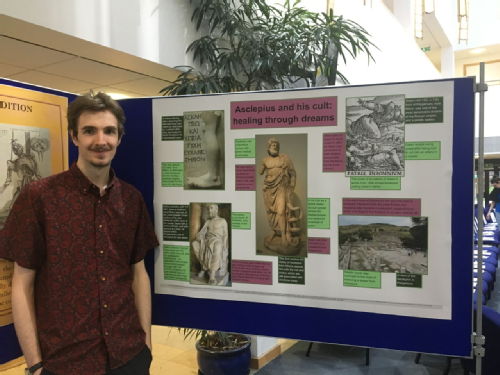 |
This month's entry was writte by Matthew Smith. Matthew is an MA by Research student at the University of Warwick. He is especially interested in Greek authors of the second century AD. His research focuses on the role which divine dreams from Asclepius played in medicine during this period, looking in particular at Galen and Aelius Aristides
Sources:
Petsalis-Diomidis, A. (2010) Truly Beyond Wonders: Aelius Aristides and the cult of Asklepios (Oxford University Press: Oxford)
Jones, C.P. (1986) Culture and Society in Lucian (Harvard University Press: Cambridge, M.A.)
Lucian, ‘Alexander the False Prophet’, in Lucian Volume IV, trans. A.M. Harmon (Harvard University Press: Cambridge, M.A. 1925)
February 01, 2019
Honours, Health and Hairstyles

Dupondius of Tiberius, Rome, AD 22-23. RIC I2 Tiberius 47, British Museum No. R.6361. Image reproduced courtesy of the Trustees of the British Museum.
This Roman copper alloy coin was produced in 22-23 AD, in the middle of Tiberius’ reign, and is held by the British Museum, but is not currently on display.
It is part of a series depicting a draped female bust, with the legend “SALVS AVGVSTA” on the obverse, while the reverse carries the abbreviation “S C”, signifying the coin was struck by a decree of the Senate, and the legend “TI.CAESAR.DIVI.AVG.F.AVG.P.M.TR.POT. XXIII”.
The obverse is understood to be a portrait of Livia Drusilla, wife of Augustus and Tiberius’ mother, who died in 29 AD, aged 86. While Livia was honoured with statues and portrait busts in her lifetime, there are no explicitly identifiable representations of her on contemporary imperial coins. Instead, depictions which may represent her on Roman imperial coins are ambiguous, carrying attributes which are identifiable with Ceres, or Pax – both of which are associated with Livia in various inscriptions, statues and possibly on the Ara Pacis. However, coins from provincial mints, particularly Greek and Egyptian, carry portraits with legends which do name her. This may partially be due to Augustus being cautious of imagery in Rome which could be construed as reflecting suggestions of monarchical ambitions. Although the idea of monarchy was abhorrent in Roman culture, it was much more acceptable and less contentious in societies in the eastern Mediterranean, which may explain why Livia was clearly portrayed there. Additionally, Marcus Antonius had featured women (Fulvia, Octavia and Cleopatra) on his coinage, and Augustus may have wished to both distance and differentiate himself from this for a variety of reasons (see August 2018 blog entry which discusses Fulvia).
Despite this, Augustus (then Octavian) had, in 35 BC, granted both Livia and his sister Octavia unprecedented honours: public protection comparable to that provided for tribunes; the right to manage their own estates without a guardian; and the right to honorific statues (see Cassius Dio, Roman History, 49.38.1). Honouring both Livia and Octavia thus had an underlying political motivation – by elevating them as paradigms of Roman matronly behaviour, Augustus obliquely, but publicly, reproached Marcus Antonius, who was living openly with Cleopatra in Egypt and mistreating Octavia, who he had married in 40 BC in an attempt to cement relations between himself and Octavian.
With the death and deification of Augustus in 14 AD, Livia had been adopted into the Julian family and was known as Julia Augusta, however the “Augusta” on the dupondius’ legend is not her name, but an adjective relating to “salus”. Tiberius gave his mother further honours, but vetoed attempts by the Senate to grant more titles to Livia – in this he followed Augustus’ lead, as he had granted Livia no official titles in his lifetime, again perhaps to avoid suggestions of monarchical ambitions. However, despite this, Livia was popularly, but unofficially, designated mater patriae (mother of her country).
In 22 AD, Livia had been seriously ill, and in view of her advancing years, her recovery was considered remarkable, and resulted in the Equestrian order dedicating a statue to Equestrian Fortune at Antium (see Tacitus Annals 3.71). The coin’s obverse legend “Salus Augusta”, is not a direct reference to this illness or recovery, although it may be understood to allude to it. Comparatively, Augustan coins from 16 BC commemorate vows for Augustus’ salus (health/safety), but on these the legend is clear “Salus Augusti”, with the genitive case clearly evidencing the salus belonged to Augustus. Instead, in this case, it is understood as being a reference to the good health of the state, and there may also be a politically-charged reference to this being dependent on Livia’s well-being.
Looking more closely at the portrait on the coin, Livia’s coiffure is arguably the most striking element. Parallel waves on the crown of her head from a central parting, connect to fuller waves across her forehead, becoming rolled braids which run from her temples to wrap the chignon, which sits at the back of her neck. Absent from this coiffure is the nodus - a wide knot of hair rolled forward to sit above the forehead.This was a defining characteristic in Livia’s portraiture in statuary prior to 14 AD.
This later hairstyle was softer and although the portrait may hint at Livia’s maturity via the fuller cheeks and perhaps the suggestion of a double chin, the overall impression is of idealised youthful Roman beauty – large eyes, an aquiline nose and strong mouth. At least four sculptural marble heads, which all date to the reign of Tiberius, match closely the coiffure shown on the Salus Augusta dupondii series, suggesting that this particular representation of Livia, not dissimilar to her coiffure on the Ara Pacis, had become more widely disseminated, although it is worth noting that the nodus portrait type of Livia was not replaced by this and continued to be used.
 |
This month's coin was written by Jacqui Butler. Jacqui has just completed the first year of the MA in Ancient Visual and Material Culture (part time), having gained a BA in Classical Studies with the Open University last year. Her main interests lie in the visual depictions of both mythical and real women in Roman material culture, specifically in art, but also their representation in epigraphy on funerary monuments.
Bibliography
Barratt, A.A. (2002) Livia: First Lady of Imperial Rome, Yale University Press.
Bartman, E. (1999) Portraits of Livia, Cambridge University Press.
Wood, S.E. (2001) Imperial Women, A Study in Public Images, 40 BC – AD68 (Mnemosyne, bibliotheca classica Batava, Supplementum 195).
December 01, 2017
A stater of Stymphalos
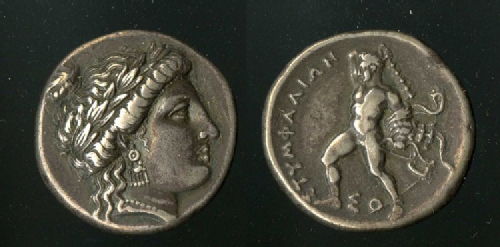 |
| A stater of Stymphalos, © The Trustees of the British Museum |
Obverse: Head of Artemis (?) with laurel wreath.
Reverse: Nude Herakles; ΣΤΥΜΦΑΛΙΩΝ upwards on left, ΣΟ beneath.
Dated mid fourth century BC, diameter 25mm, weight: 11.75g.
Stymphalos was located near the present-day town of Stymfalia, in a mountain valley in north-west Arcadia. In Greek literature, it is famous as the site of the sixth Labour of Herakles – in which he battled the carnivorous Stymphalian birds. The site was first excavated by Anastasios Orlandos during the 1920s. More recently, excavations by the University of British Columbia (led by Prof. Hector Williams) took place between 1994 and 2001. Amongst the finds were a large quantity of coins – 492 in total – yet of this figure, only five of the coins found were minted in Stymphalos itself.
This coin is a silver stater, minted in the mid fourth century BC. On the obverse, we see a bust of a female deity, crowned with a laurel wreath. This has previously been identified as Artemis, due to the archaeological material pertaining to a female goddess at the acropolis sanctuary at Stymphalos. Archaic figurines found in the excavation are seen holding a small animal in one hand – thought to be a hare – an animal often depicted with Artemis. In addition, references attesting the worship of the ‘Braurion Artemis’ at Stymphalos support the view of there being a sanctuary to the goddess. However, votive offerings found at the sanctuary allude to dedications to Eileithyia, and we know from Pausanias that she was worshipped in the region. Coins at Argos have also been found bearing the portrait of Eileithyia, and so it is not unreasonable to suggest that the deity depicted here could be either Eileithyia or Artemis.
The reverse displays a portrait of Herakles in action: with one hand raised, holding a club, and the other with bow and arrow, with the inscription ‘ΣΤΥΜΦΑΛΙΩΝ’ on the left-hand side. The lionskin that he is usually depicted wearing as a headpiece is instead flung around his left arm. This depiction of Herakles differs from other coins minted at Stymphalos (one is pictured below), where he is shown in portrait style, with an image of a Stymphalian bird in profile on the reverse. It would be safe to presume in this instance, that the two images: Herakles and the Stymphalian bird, have been combined in an active portrait showing Herakles in the midst of battle in his sixth labour.
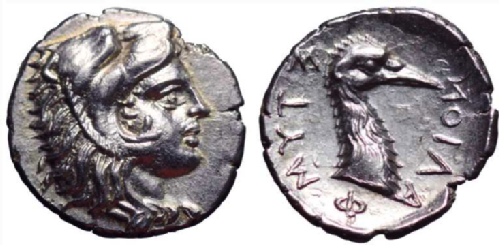 |
| Silver obol of Stymphalos, c. 350 BC, 12mm, 0.95g. |
From Xenophon, we know that citizens of Stymphalos were employed as mercenaries at the end of the fifth century and throughout the fourth century BC. This would account for the presence of foreign coinage at Stymphalos, and would perhaps indicate why so little of the city’s own coinage was in circulation – perhaps it was being carried and traded at other cities across Greece. Coins from neighbouring city mints such as Phlious were found at Stymphalos in larger quantities than the local mint, suggesting that Stymphalos only minted currency when necessary, such as in recovery after an attack. Xenophon dates the attack of Iphikrates to 391 BC, but Schaus gives reason for suggesting that if the attack took place, it more likely would have occurred in 370-369 BC. If we take Schaus’ suggestion, then the timing of the attack would seem a reasonable catalyst for the minting of this coin and other from the mid fourth century BC.
Stymphalos was neighboured by Argos, Corinth and Sikyon within a 30 mile radius, and their prominence overshadowed the city. This coin demonstrates a strong regional identity, with mythology interwoven as part of the historical fabric of the city. Distribution outside the city at the hands of mercenaries allows the iconography of this coin to re-establish Stymphalos’ significance in the mythological history of Greece.
 |
This month's entry was written by Alice Clinch, a Masters student in the department of Classics and Ancient History at Warwick. She has worked on fieldwork projects in Greece and Sicily, and is particularly interested in constructed sacred space and ritual activity in cults.
Bibliography
Imhoof-Blumer, F. and Gardner, P. (1885). Numismatic Commentary on Pausanias. The Journal of Hellenic Studies, 50-101.
Robinson, E. (1901). Report of the Curator of Classical Antiquities. Annual Report for the Year ... (Museum of Fine Arts, Boston), 28-72.
Schaus, G. P. (2014). Stymphalos: Ancient Sources and Early Travellers. In G.-L. e. al., & G. P. Schaus (Ed.), Stymphalos, Volume One: The Acropolis Sanctuary (pp. 6-11). Toronto: University of Toronto Press.
Sturgeon, M. (2014). Sculpture. In Garvie-Lok. et. al., & G. P. Schaus (Ed.), Stymphalos, Volume One: The Acropolis Sanctuary (pp. 36-55). Toronto: University of Toronto Press.
Weir, R. (2007). The Stymphalos Hoard of 1999 and the City's Defenses. American Journal of Numismatics, 9-32.
November 01, 2017
Two Sides of a Coin: Slavery and Religion in the First Servile War

Coin of Eunus (King Antiochus). © The Trustees of the British Museum.
Obverse: Head of Demeter right, veiled with grain-wreath.
Reverse: Ear of grain; ΒΑΣΙ(λέως) upwards on left, ΑΝΤΙΟ(χου) downwards on right.
The late Republic was rocked by three major slave revolts which were unique in their size and extent. The first, and largest, was the First Servile War from c.135 to 132 BC. The extent was such that rebel slaves began to mint coinage and a large portion of eastern and central Sicily was under their control including Enna, Tauromenium, Agrigentum, and possibly Morgantina, Catana, and Syracuse. However, it was a doomed effort and the revolt was finally put down 132 BC as the last cities, Enna and Tauromenium were captured by the consul Publius Rupilius.
 |
| Robinson 1920, 175 |
The revolt began when the slave Eunus led a band of slaves and captured the city of Enna. This city was famous and renowned in antiquity for its cult of Demeter. Cicero stated the people seemed, “not to be citizens of that city, but to be all priests, to be all ministers and officers of Ceres” and when going to the city’s temple one was “going not to a temple of Ceres, but to Ceres herself” (Cicero, Against Verres 2.4.108, 2.4.111). Eunus was then crowned King Antiochus at Enna and minted four issues of coins. These coins are exceptionally rare and only 18 specimens are known. The rarity combined with a poor state of conservation has left the imagery on three of the coins uncertain but local gods and religious imagery are among the possibilities. These coins also included the legend Basileus Antiochou ([coin] of King Antiochus) which advertised Eunus’ newly assumed name and title as well as his legitimacy as King. This month’s coin (with a drawing of the type reproduced here) is the only of these four issues to bear imagery which has been identified with certainty. It depicts Demeter, the goddess of Antiochus’ capital Enna on the obverse with an ear of grain, a symbol associated with the goddess, on the reverse.
The literary sources on Antiochus’ revolt are universally hostile and interpret the role of religion in the revolt differently than what is suggested through the coinage. Instead of Demeter or any of the other local gods which may have been depicted on his coinage, the literary sources emphasize Eunus’ status as a charlatan, a magician, and a follower of the foreign goddess Atargatis which manipulated and deceived his fellow rebels. This served to not only dissociate the revolt from Demeter, the goddess of Enna who was also revered and respected by the Romans, but also to support an account filled with negative slave stereotypes.
Gordon stated, “slave was synonymous with gullible in the Roman mind” [Gordon 1999, 194]. Roman slave owners were specifically warned against allowing slaves to consult fortune tellers, prophets, diviners, and astrologers “who incite ignorant minds through false superstition to spending and then to villanies (flagitia)” (Cato, On Agriculture 5.4).
Antiochus is depicted as exactly the type of fortune teller, prophet, and diviner that Roman slave owners had been warned about.
There was a certain Syrian slave (King Antiochus)… and [he] had an aptitude for magic and the working of wonders. He claimed to foretell the future, by divine command, through dreams, and because of his talent along these lines deceived many. Going on from there he not only gave oracles by means of dreams, but even made a pretense of having waking visions of the gods and of hearing the future from their own lips. Of his many improvisations some by chance turned out true, and since those which failed to do so were left unchallenged, while those that were fulfilled attracted attention, his reputation advanced apace. Finally, through some device, and while in a state of divine possession, he would produce fire and flame from his mouth, and thus rave oracularly about things to come. (Diodorus Siculus 34/35.2.5-9).
Coinage helps to provide a voice for those who do not have their own. The slaves of the revolt have only their coinage to provide their side of the story. This coinage directly contradicts the stereotyped accounts in the literary history and instead depicts a king who represented himself not with a foreign goddess Atargatis but instead with Demeter and traditional iconography.
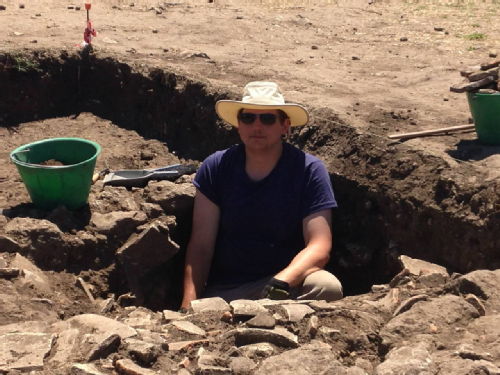 |
This month's coin of the month was written by James Currie. James is a PhD candidate in the department, researching The Transformation of the Sacred Landscape of Republican and Early Imperial Sicily. His research aims to better understand the province of Sicily’s transition from the Republican to early Imperial period through the sacred landscape by investigating the transformation and continuity of “public” religion through the temples and sanctuaries. It also seeks to better understand the province’s political and social changes and how these were both impacted by and influenced the sacred landscape.
Bibliography
Bradley, K. 1989. Slavery and Rebellion in the Roman World 140 BC-70 BC. London: Batsford.
Dickie, M. 2001. Magic and Magicians in the Greco-Roman World. Routledge.
David, E. 2011, "Ein syrisches Sizilien? Seleukidische Aspekte des Ersten Sizilischen Sklavenkriegs und der Herrschaft des Eunus-Antiochos." Polifemo 11: 233–251.
Gordon, R. 1999. "Imagining Greek and Roman Magic". in Ankarloo, B. and Clark, S. (eds) Witchcraft and Magic in Europe: Ancient Greece and Rome. 159-275. London.
Hinz, V. 1998. Der Kult von Demeter und Kore auf Sizilien und der Magna Graecia. Wiesbaden.
Manganaro, G. 1982. “Monete e ghiande inscritte degli schiavi ribelli in Sicilia”. Chiron. 12: 237-244.
Manganaro, G. 1983. “Ancora sulle rivolte servili in Sicilia.” Chiron. 13: 405-409.
Manganaro, G. 1990. "Due studi di numismatica greca". Annali della Scuola Normale Superiore di Pisa. Classe di Lettere e Filosofia 20: 409-27.
McKeown, N. 2012. "Magic, Religion, and the Roman Slave: Resistance, Control and Community". in Hodkinson, S. and Geary, D. (eds) Slaves and Religions in Graeco-Roman Antiquity and Modern Brazil. 279-308. Cambridge.
Morton, P. 2013. “Eunus: The Cowardly King”. Classical Quarterly: 63: 237-252.
Robinson, E.S.G. 1920. “Antiochus, King of Slaves” Numismatic Chronicle 4.20: 175-6.
Sánchez León, M.L. “La amonedación del basileus Antíoco en Sicilia: (Siglo II AC.)” in Chaves Tristán, F and García Fernández, F.J. (eds) Moneta qua scripta: la moneda como soporte de escritura: actas del III Encuentro peninsular de numísmatica antigua, Osuna (Sevilla), Febrero-Marzo 2003. 223-8. Sevilla.
March 01, 2015
Septimius Severus and his DI PATRII Coinage: A Tale of Two Identities
 |
| Denarius of Septimius Severus (CNG Mail Bid Sale 73, lot 943) |
For the most part, research of the Roman concept of patria (definable as a complex embodiment of Roman collective identity) is dominated by the analysis of literary and epigraphic data. Offering a fresh perspective on this important concept is a single coin type, the only one from the Roman world in fact to bear the word patria in its legend outwith the imperial title pater patriae. Minted between AD 200 and 204 by the emperor Lucius Septimius Severus (emperor from AD 193-211) and his sons Geta and Caracalla in a variety of denominations, the obverse depicts (in this case) the bust of the emperor and bears the legend SEVERVS PIVS AVG. P.M. TR.P. XII (Severus Pious Augustus, Pontifex Maximus, holder of the Tribunician Power for the twelfth time). On the reverse are depicted two gods. Facing to the right is Liber Pater. In his hands he holds a cup and thyrsus (a wand or staff), and at his feet sits a panther. Facing to the left is Hercules, clearly identifiable by the club and lion skin. They are accompanied by the legend DI PATRII (gods of the patria).
In order to explain the significance of this coin type, three interpretations have so far been proposed, all of which rightly identify the coin type’s function as a visual representation of the emperor’s identity. Firstly, the German scholar Hasebroek has suggested that the coin could have been struck to commemorate Severus’ visit to Africa in AD 204, which would have included a stop off at the city of Lepcis Magna. Lepcis Magna was the patria of Severus, and its tutelary gods were Shadaphra and Melqart, the Lepcitanian equivalents respectively of Liber Pater and Hercules. However, this interpretation has recently been discarded due to the fact that evidence suggests Severus’ African tour took place in AD 207, three years after the latest issuing of the DI PATRII coin type. A second suggestion has been put forward by Barnes, who has argued that the coin was struck to commemorate the commencement and dedication of a temple to the gods Liber Pater and Hercules at Rome. However, very little physical evidence exists for us to be entirely sure that such a temple was constructed. Most recently, Rowan has expanded on Barnes’ argument, and has proposed that the coin marks the moment in which Liber Pater and Hercules became the di patrii of Rome.
So does the coin indicate the emperor’s Roman identity or his African origins? I would argue that the coin simultaneously represents both. Iconographically, the coin would appear to symbolise Severus’ African birthplace, and hence identity. As stated above, Liber Pater (Shadaphra) and Hercules (Melqart) were the tutelary deities of Lepcis Magna. This is indicated by several inscriptions from the city, their prominence in Lepcitanian sculpture and the fact that their temples occupied central locations within the old forum. It is also clear that the gods were important to Severus on a personal level, being also the tutelary deities of his regime, appearing in several other coin issues during his reign. Furthermore, whilst the joint appearance of Liber Pater and Hercules is identifiable in the coinage of Lepcis Magna from the first century BC to the first century AD, this is the first time that these gods appear together in any form on Roman coinage.
Iconographically, therefore, the coin seems to proudly display Severus’ Lepcitanian identity. Surely, therefore, the legend DI PATRII must correspond to them also, stressing their role as the tutelary gods of his African patria? A consideration of epigraphic and literary evidence would seem to question this argument. Epigraphically, the legend DI PATRII is one that is very rarely found outside of Rome or Italy. With regard to the inscriptions in Lepcis Magna that refer to Liber Pater and Hercules, only one describes them in this way. Their most common epigraphic description is instead either GENII COLONIAE (guardian deities of the colonia) or DIBVS LEPCIS MAGNAE (gods of Lecpis Magna). In literature also, the phrase di patrii appears to have been used almost exclusively in relation to the gods of Rome, particularly with regards to the penates that were according to legend brought to Italy from Troy by Aeneas. Consequently, the phrase is frequently identified in Virgil’s great ‘national’ epic The Aeneid. It is also prominent, to give only one further example, within the speeches of Cicero, an individual who places particular emphasis upon the fundamental relationship between res publica and patria in his writings.
This coin, therefore, can be seen to symbolise Severus’ local Lepcitanian identity alongside his that of his role as the cultural and religious leader of the Roman world. However, how do we contextually account for this apparent dual-identity? As stated above, this coin type was issued between AD 200 and 204. In AD 204, the Saecular Games were held. This event occurred every 110 years (although there was much flexibility in this) and marked the beginning of a new saeculum (era). The games were a moment in which to celebrate the continuation of Roman power and religious identity but they often contained elements of novelty reflecting the theme of a new beginning. Yet, exactly how does the coin fit into this context of tradition accompanied by novelty? The coin’s legend DI PATRII is clearly a nod to Roman tradition, since, as we have seen from the literary passages, it was a phrase that had important connotations to Roman collective identity. The iconography, however, indicates novelty. It is the first time that these two gods appear together on a single Roman coin, and they clearly stress the emperor’s pride in his native, and hence non-Roman, origins. It is true that other emperors also displayed personal deities on coinage during such events, but they did so with Roman religious iconography firmly in mind, and there is no indication that in doing so they are making a direct reference to their native origins, their local patriae. Thus, issued at a time which celebrated Romanitas, I would advocate the interpretation that Severus’ DI PATRII coinage is a wonderful statement of the equal importance that was placed upon local and imperial identities, proudly displaying the emperor’s attachment to his local patria, whilst also honouring the religious elements that were at the heart of Rome’s conceptualisation of patria.
 This month's coin is contributed by Alexander Peck. Alex is currently a third year PhD student in the Department of Classics and Ancient History at the University of Warwick. His thesis examines the Roman concept of the patria. It considers the ways in which it was conceptualised by the Romans; how this conceptualisation changes over time; how the concept was institutionalised; and the concept’s role within Roman politics. He obtained his first degree, a first class MA (Hons) in Classics and Italian, from the University of Glasgow in 2012. He has a great interest in interdisciplinary collaboration on the subject of collective identity, especially on the question of the origins and evolution of nationalism. He is currently the editor for a forthcoming volume for Pickering and Chatto’s Warwick Series in the Humanities entitled Nationhood: From Antiquity to Modernity.
This month's coin is contributed by Alexander Peck. Alex is currently a third year PhD student in the Department of Classics and Ancient History at the University of Warwick. His thesis examines the Roman concept of the patria. It considers the ways in which it was conceptualised by the Romans; how this conceptualisation changes over time; how the concept was institutionalised; and the concept’s role within Roman politics. He obtained his first degree, a first class MA (Hons) in Classics and Italian, from the University of Glasgow in 2012. He has a great interest in interdisciplinary collaboration on the subject of collective identity, especially on the question of the origins and evolution of nationalism. He is currently the editor for a forthcoming volume for Pickering and Chatto’s Warwick Series in the Humanities entitled Nationhood: From Antiquity to Modernity.
Coin image reproduced courtesy of Classical Numismatic Group Inc., (Mail Bid Sale 73, lot 943) (www.cngcoins.com)
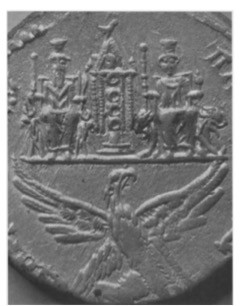
 Clare Rowan
Clare Rowan

 Please wait - comments are loading
Please wait - comments are loading

 Loading…
Loading…

